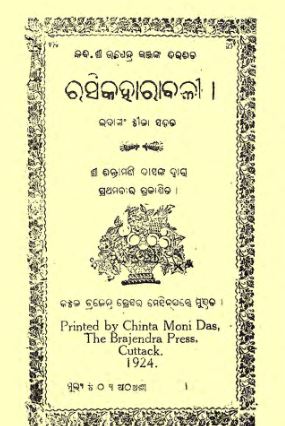The rich tapestry of Indian literature is adorned with myriad regional gems, each contributing to the vibrant mosaic of the nation’s cultural heritage. Among these, Odia literature holds a special place, with lineage that boasts of eloquent poets and writers who have shaped its course through the centuries. One such luminary is Upendra Bhanja, whose classic work, Rasikaharabali, continues to mesmerize readers even today. Published in 1924, this collection of poetry remains a testament to Bhanja’s prowess in blending lyrical beauty with profound philosophical insights.
Rasikaharabali is not just a poetry collection; it is an odyssey through the labyrinth of human emotions, nature’s splendor, and the divine. Upendra Bhanja, often revered as the “Kalidasa of Odisha,” skillfully employs his mastery over language to craft verses that are as musical as they are meaningful. This book encapsulates his talent for weaving intricate metaphors with a poetic elegance that has rarely been surpassed.
One of the distinctive features of Rasikaharabali is its exploration of the concept of Rasa, an aesthetic flavor or emotion that is central to Indian art and literature. Bhanja’s poems delve into various Rasas — from the romantic and erotic to the heroic and tranquil. This thematic diversity ensures that Rasikaharabali resonates with a broad spectrum of readers, offering something for everyone, whether they seek the solace of serenity or the thrill of passion.
Bhanja’s ability to paint vivid imagery with words is another hallmark of Rasikaharabali. His descriptions of natural landscapes are so evocative that they transport readers to the lush greenery of Odisha, its serene rivers, and its majestic temples. For instance, in one of his celebrated poems, Bhanja likens the beauty of a woman to the ethereal charm of a blooming lotus on the banks of the Mahanadi river. Such imagery not only highlights his appreciation for nature’s beauty but also his skill in drawing parallels between the human and natural worlds.
In the realm of Odia literature, Rasikaharabali is celebrated for its linguistic richness. Upendra Bhanja’s dexterity with the Odia language is evident in his clever use of alliteration, assonance, and rhythmic cadence. His verses are a joy to read aloud, each syllable resonating with musicality that enhances the overall poetic experience. This linguistic finesse also serves to preserve and propagate the beauty of the Odia language, reinforcing its significance in India’s literary canon.
Rasikaharabali also offers readers a glimpse into the socio-cultural landscape of 18th-century Odisha, albeit through a poetic lens. Bhanja’s reflections on love, devotion, and valor are deeply rooted in the cultural and philosophical ethos of his time. Through his poetry, he not only entertains but also educates, inviting readers to contemplate the deeper meanings of life and existence.
The publication of Rasikaharabali in 1924, although posthumous, marked a significant event in the preservation and revival of Upendra Bhanja’s work. It allowed subsequent generations to access and appreciate the genius of a poet who, despite the passage of time, continues to inspire. In the annals of Indian literature, Rasikaharabali holds a cherished spot, reminding us of the timeless allure of poetry and the enduring legacy of its creators.
In conclusion, Rasikaharabali by Upendra Bhanja is more than just a collection of poems; it is a cultural artifact that encapsulates the essence of Odia literature. Its allure lies in its harmonious blend of emotion, imagination, and linguistic brilliance. For anyone seeking to delve into the depths of classic poetry, this book stands as a beacon of literary excellence, a true testament to the timeless beauty of Upendra Bhanja’s poetic genius.
Books Info
| Books name | Rasikaharabali/ରସିକହାରାବଳୀ |
| Author | Upendra Bhanja |
| No Of pages | 138 |
| Publisher | Arohi |
| Publication | 1924 |
| Printed At | Techno Arts Offset |
| Distributor | NA |

